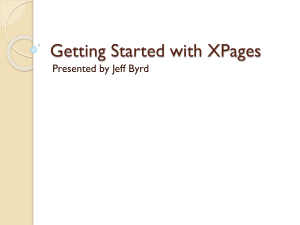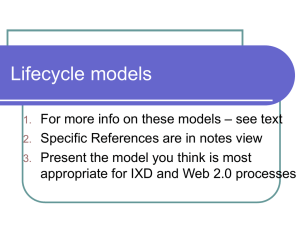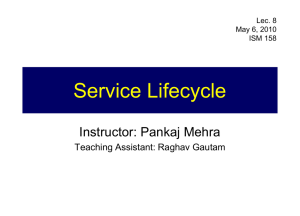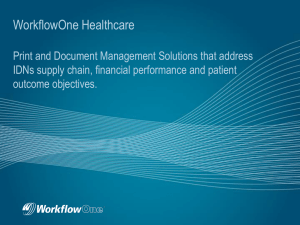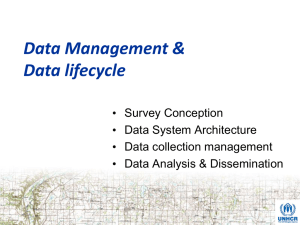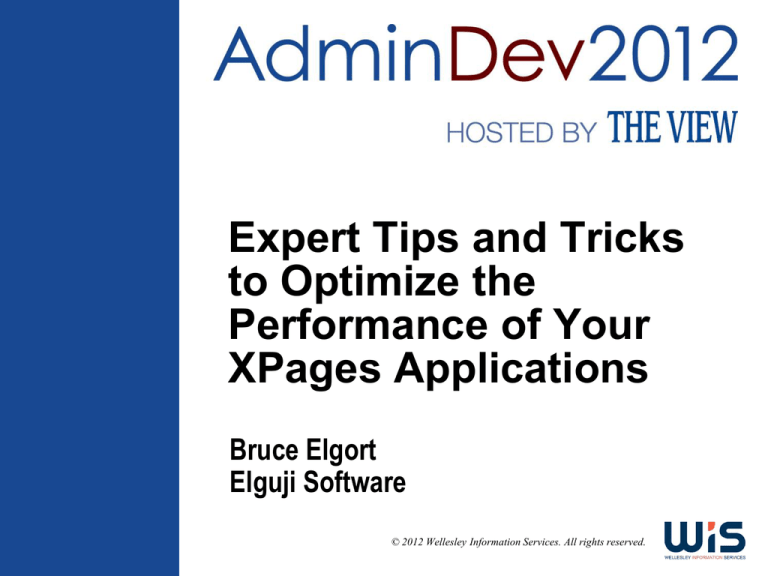
Expert Tips and Tricks
to Optimize the
Performance of Your
XPages Applications
Bruce Elgort
Elguji Software
© 2012 Wellesley Information Services. All rights reserved.
In This Session ...
•
•
•
Users expect that applications are fast and responsive
Isn’t it funny how you only hear from them when they are slow
and poorly designed
XPages does all this for me, right? Nope.
XPages gives us a powerful set of development tools right out of
the box, however …
They sometimes don’t perform as well as we had hoped
Or we used XPages when a classic Domino application could
have done the trick
This session is designed to help developers optimize the
performance of their XPages applications
1
What We’ll Cover …
•
•
•
•
•
•
Things to consider when moving applications to XPages
Understanding the JSF lifecycle and how it relates to XPages
application design
Development best practices for performance and scalability
How to identify application bottlenecks using the OpenNTF
XPages Toolbox
Third-party tools to help profile your applications performance
Wrap-up
2
XPages Application Design Considerations
•
When should you:
Migrate a Notes/Domino application to XPages?
Avoid developing/migrating applications to XPages?
Consider a “hybrid” approach?
3
Migrating an Application to XPages
•
Consider migrating an application to XPages if:
It’s an active application that brings value to the business
Functionality can be moved to the browser without much
disruption and/or retraining
It is not required to be used offline
Notes “only” applications that now require Web browser access
The applications need a facelift and/or require new functionality
4
Avoid Using XPages
•
You may want to avoid using XPages if:
Notes encryption is required
The app depends on COM for calling other applications such as
Word or Excel
Makes heavy use of rich text
Integration with calendaring and scheduling is required
You have stable complex applications that are mission-critical
and running the business
You have applications that are better suited for a Notes client
user experience
5
When to Consider a Hybrid Approach
•
•
A hybrid approach is one that utilizes classic Notes and Domino
design elements, as well as ones developed using XPages
Consider a hybrid approach when:
You have Notes client apps that require Web browser and/or
mobile support yet still require use of the Notes client
You need to add REST services, report generation, or other
services using XPages “XAgents”
When you are first starting to learn XPages
When only a subset of features are needed from the Web and/or
mobile device
6
What We’ll Cover …
•
•
•
•
•
•
Things to consider when moving applications to XPages
Understanding the JSF lifecycle and how it relates to XPages
application design
Development best practices for performance and scalability
How to identify application bottlenecks using the OpenNTF
XPages Toolbox
Third-party tools to help profile your applications performance
Wrap-up
7
Understanding the JSF Lifecycle
•
•
XPages is built on the JavaServer Faces framework
It is important to understand the principles of this framework
Stateful Web application architecture
Component-based architecture
Every tag has a server-side object representation
Saving and restoring state
Validation
Rendering the tags/markup to the client
Uses a six-phase life cycle that is extended by XPages
8
The 6 Phase JSF Request Processing Lifecycle
1.
2.
3.
4.
5.
6.
Restore View – Retrieves the JSF view for the request
Apply Request Values – Updates the JSF components to update their
state based on values from the current request
Process Validations – Validators invoked
Update model values – Application data is updated with new values.
Values are written to the Domino back-end document during this
phase.
Invoke applications – Application logic executed
Render response – Generates the response and saves the state of
the view
9
More on the JSF Lifecycle Phases and What They Do
•
•
•
Phases 1 and 6 are “system-level” phases
They are going to happen no matter what we do to our code
Phases 2, 3, 4, and 5 are “application-level phases”
These phases are something we as developers can use to our
advantage
By understanding how we can tweak our XPages objects to
make more efficient use of the JSF lifecycle
We will explore how your XPages can skip some of the six phases
which in turn reduce CPU utilization processing and increase
speed
10
The JSF Lifecycle
www.ibm.com/developerworks/library/j-jsf2/
11
The Link Control and the JSF Lifecycle
•
•
•
Let’s start off by looking at the link control
The link control is used to place a hypertext link on an XPage or
in a custom control
When you place the link control on your XPage and use a “simple
action” to set the link you will see this in your XPage markup
<a id="view:_id1:link1" href="#" class="xspLink">Link</a>
When you inspect what the browser is doing when the link is
clicked you will see that the browser is issuing a “POST” request
to the server
This is using phases 2-5 of the JSF lifecycle and is a more
“expensive” operation
An extra trip is being made to the server to resolve the # in the
link
12
The Link Control and the JSF Lifecycle (cont.)
•
•
•
Changing the simple action to a defined page in the link
properties will now generate this code
<a id="view:_id1:link1" href="/xpagesplay.nsf/contact.xsp"
class="xspLink">Link</a>
This will eliminate the need for:
A round trip to the server (POST) is now bypassed as are
phases 2-5 of the JSF lifecycle
Use direct links whenever possible
These will generate GET requests
Save CPU time
Generate a snappier user experience
13
What We’ll Cover …
•
•
•
•
•
•
Things to consider when moving applications to XPages
Understanding the JSF lifecycle and how it relates to XPages
application design
Development best practices for performance and scalability
How to identify application bottlenecks using the OpenNTF
XPages Toolbox
Third-party tools to help profile your applications performance
Wrap-up
14
The Read-Only Property
•
Setting the read-only property of a Panel in Domino Designer
15
The Read-Only Property (cont.)
•
•
•
•
•
Use Panel controls where no server-side JavaScript or simple
actions are contained in the panel that don’t require processing
Panel controls generate HTML divs which are used to place
other components within
Set this to true in the Properties panel
Other considerations:
The other thing you should consider is not using the Panel core
control but rather an HTML div instead
This is also true for any other HTML element that doesn’t
require any processing
Remember that only <xp:> tags are processed during the JSF
lifecycle
Setting read-only to “true” skips JSF phases 2-5
16
The Immediate Property
•
•
This does not validate or update any data
No server validation will occur
No further processing of the XPages component tree will occur
Just do what I say “immediately” and Cancel!
Typically used on a Cancel button
Set the value to true
<xp:button value="Cancel" id="button2"><xp:eventHandler
event="onclick" submit="true" refreshMode="complete"
save="false"
immediate="true"></xp:eventHandler></xp:button>
•
Setting the immediate property to “true” skips JSF phases 3-5
17
The Immediate Property (cont.)
•
•
Here is our Cancel button in Domino Designer showing the “Do
not validate or update data” option is checked
This sets the value to true in the XPage XML source
18
Partial Refresh
•
A radio button under a controls Server Options that allows you to
select the target component that will be refreshed
Reduces the amount of HTML markup that must be processed
and emitted
Less HTML and other elements means that the application is
more responsive
The entire page does not have to be reloaded
Makes Phase 6 (Render response) of the JSF lifecycle very fast
and efficient
Only the selected/component branch of the JSF tree is updated
There may be some side effects which will require you to
force the entire tree to update
19
Partial Refresh (cont.)
•
•
If you want the server to always render the whole view tree you
can:
Add xsp.ajax.renderwholetree=true to the xsp.properties
This file is in the WebContent/WEB-INF/ directory
Use Partial Refresh where ever possible so only that portion of
the JSF tree is processed and not the entire component tree
20
The DataCache Property
•
•
•
•
Used for caching Domino view data
Persisted view data consumes JVM memory
Use if the view data isn’t needed in a POST request
Three values are supported for the DataCache property:
Full [default]
The entire view is persisted
ID
Minimal scalar data ID and position. Access to column values
during a POST are not available.
None
Enough said – the entire view needs to be reconstructed
21
Partial Execution
•
•
•
Controls how much component tree processing happens during
phases 2-5 of the JSF lifecycle
Partial Execution is purely a server-side optimization
Partial Refresh and Partial Execution are mutually exclusive and
do not depend on each other in any way
22
Partial Execution (cont.)
•
•
•
Set the execMode property on server events using:
“Set partial execution mode” in the Server Settings section
The default is “complete” and when checked is set to “partial”
Very powerful when used inside of a View Panel, Data Table, or
Repeat Control
Child controls can have this property set which will not cause
the parent control to not be re-executed during invocation of a
child event handler
Did I mention that this is very powerful and you should carefully
review your code to ensure that you are taking advantage of
Partial Execution wherever possible?
23
Exploring the XPages Request Processing Lifecycle
•
•
•
•
So how do you know when and where your code is executing in
the JSF Lifecycle?
Couple this with Partial Refresh and Partial Execution of controls
and things can become pretty complex exponentially.
IBM’s Tony McGuckin has posted code on the OpenNTF
Xsnippets site that will help you learn more about the JSF
lifecycle. It will also clearly show you which phase(s) of the
lifecycle your code is being executed.
A sample XPage is included.
http://openntf.org/XSnippets.nsf/snippet.xsp?id=xpa
ges-request-processing-lifecycle-explorer-code...
24
The Sample XPage
•
The sample XPage that we are going to examine has:
The XPage view has the following event handlers defined:
beforePageLoad
afterPageLoad
afterRestoreView
beforeRenderResponse
afterRenderResponse
Each of these events has a print statement that will print out to
the Domino console
Let’s look at the page design and them walk through some of
examples
25
Sample Lifecycle XPage Layout
Domino Designer Design View
26
Sample Lifecycle XPage Layout (cont.)
Web browser view
27
LifeCycle.nsf Page Initial Load Output
•
All of the controls are rendered and then JSF Phase 6
28
P2 Button Clicked Output
•
•
Button P2’s onclick event is set to Partial Refresh of the P2 panel
Partial Execution Mode has also been selected with an execId of
P2
29
P2 Immediate Button Clicked Output
•
•
•
•
Button P2’s click event is set to Partial Refresh of the P2 panel
Partial Execution Mode has also been selected and set to execId P2
The immediate property of the button’s onclick event has been set
which will bypass any validation
Typically used to save a document in draft form
30
P2 Button Disable Validators Clicked
•
•
•
Button P2’s click event is set to Partial Refresh of the P2 panel
Partial Execution Mode has also been selected and set to execId P2
The “Process data without validation” checkbox is enabled
(disableValidators=“true”). All phases are executed.
31
P1 Button Clicked
•
•
•
Button P1’s click event is set to Partial Refresh of the P1 panel
Partial Execution Mode has also been selected and set to execId P1
Pretty much what we expected
32
P1 Button Immediate Clicked
•
•
•
Button P1’s click event is set to Partial Refresh of the P1 panel
Partial Execution Mode has also been selected and set to execId P1
The immediate property of the button’s onclick event has been set
which will bypass any validation
33
P1 Button Disable Validators Clicked
•
•
•
Button P1’s click event is set to Partial Refresh of the P1 panel
Partial Execution Mode has also been selected and set to execId P1
The “Process data without validation” checkbox is enabled
(disableValidators=“true”). All phases are executed.
34
P2 No ID Partial Execute/Full Refresh
•
•
•
•
•
•
•
•
•
•
•
•
•
•
•
•
•
•
•
•
•
•
•
•
•
•
•
•
•
•
•
•
•
•
•
05/10/2012
05/10/2012
05/10/2012
05/10/2012
05/10/2012
05/10/2012
05/10/2012
05/10/2012
05/10/2012
05/10/2012
05/10/2012
05/10/2012
05/10/2012
05/10/2012
05/10/2012
05/10/2012
05/10/2012
05/10/2012
05/10/2012
05/10/2012
05/10/2012
05/10/2012
05/10/2012
05/10/2012
05/10/2012
05/10/2012
05/10/2012
05/10/2012
05/10/2012
05/10/2012
05/10/2012
05/10/2012
05/10/2012
05/10/2012
05/10/2012
08:46:14
08:46:14
08:46:14
08:46:14
08:46:14
08:46:14
08:46:14
08:46:14
08:46:14
08:46:14
08:46:14
08:46:14
08:46:14
08:46:14
08:46:14
08:46:14
08:46:14
08:46:14
08:46:14
08:46:14
08:46:14
08:46:14
08:46:14
08:46:14
08:46:14
08:46:14
08:46:14
08:46:14
08:46:14
08:46:14
08:46:14
08:46:14
08:46:14
08:46:14
08:46:14
AM
AM
AM
AM
AM
AM
AM
AM
AM
AM
AM
AM
AM
AM
AM
AM
AM
AM
AM
AM
AM
AM
AM
AM
AM
AM
AM
AM
AM
AM
AM
AM
AM
AM
AM
HTTP
HTTP
HTTP
HTTP
HTTP
HTTP
HTTP
HTTP
HTTP
HTTP
HTTP
HTTP
HTTP
HTTP
HTTP
HTTP
HTTP
HTTP
HTTP
HTTP
HTTP
HTTP
HTTP
HTTP
HTTP
HTTP
HTTP
HTTP
HTTP
HTTP
HTTP
HTTP
HTTP
HTTP
HTTP
JVM:
JVM:
JVM:
JVM:
JVM:
JVM:
JVM:
JVM:
JVM:
JVM:
JVM:
JVM:
JVM:
JVM:
JVM:
JVM:
JVM:
JVM:
JVM:
JVM:
JVM:
JVM:
JVM:
JVM:
JVM:
JVM:
JVM:
JVM:
JVM:
JVM:
JVM:
JVM:
JVM:
JVM:
JVM:
Request:
Started...
Lifecycle:
Page:
Lifecycle:
Before Phase: RESTORE_VIEW 1
view1->afterRestoreView
After Phase: RESTORE_VIEW 1
Lifecycle:
Control:
Lifecycle:
Before Phase: APPLY_REQUEST_VALUES 2
txt2->rendered
After Phase: APPLY_REQUEST_VALUES 2
Lifecycle:
Control:
Lifecycle:
Before Phase: PROCESS_VALIDATIONS 3
txt2->rendered
After Phase: PROCESS_VALIDATIONS 3
Lifecycle:
Control:
Lifecycle:
Before Phase: UPDATE_MODEL_VALUES 4
txt2->rendered
After Phase: UPDATE_MODEL_VALUES 4
Lifecycle:
Lifecycle:
Before Phase: INVOKE_APPLICATION 5
After Phase: INVOKE_APPLICATION 5
Lifecycle:
Page:
Control:
Control:
Control:
Page:
Lifecycle:
Before Phase: RENDER_RESPONSE 6
view1->beforeRenderResponse
txt1->rendered
txt2->rendered
txt3->rendered
view1->afterRenderResponse
After Phase: RENDER_RESPONSE 6
Request:
Completed.
35
P2 Full Execute/Partial Refresh
•
•
•
•
•
•
•
•
•
•
•
•
•
•
•
•
•
•
•
•
•
•
•
•
•
•
•
•
•
•
•
•
•
•
•
•
•
•
•
•
05/10/2012
05/10/2012
05/10/2012
05/10/2012
05/10/2012
05/10/2012
05/10/2012
05/10/2012
05/10/2012
05/10/2012
05/10/2012
05/10/2012
05/10/2012
05/10/2012
05/10/2012
05/10/2012
05/10/2012
05/10/2012
05/10/2012
05/10/2012
05/10/2012
05/10/2012
05/10/2012
05/10/2012
05/10/2012
05/10/2012
05/10/2012
05/10/2012
05/10/2012
05/10/2012
05/10/2012
05/10/2012
05/10/2012
05/10/2012
05/10/2012
05/10/2012
05/10/2012
05/10/2012
05/10/2012
05/10/2012
08:49:31
08:49:31
08:49:31
08:49:31
08:49:31
08:49:31
08:49:31
08:49:31
08:49:31
08:49:31
08:49:31
08:49:31
08:49:31
08:49:31
08:49:31
08:49:31
08:49:31
08:49:31
08:49:31
08:49:31
08:49:31
08:49:31
08:49:31
08:49:31
08:49:31
08:49:31
08:49:31
08:49:31
08:49:31
08:49:31
08:49:31
08:49:31
08:49:31
08:49:31
08:49:31
08:49:31
08:49:31
08:49:31
08:49:31
08:49:31
AM
AM
AM
AM
AM
AM
AM
AM
AM
AM
AM
AM
AM
AM
AM
AM
AM
AM
AM
AM
AM
AM
AM
AM
AM
AM
AM
AM
AM
AM
AM
AM
AM
AM
AM
AM
AM
AM
AM
AM
HTTP
HTTP
HTTP
HTTP
HTTP
HTTP
HTTP
HTTP
HTTP
HTTP
HTTP
HTTP
HTTP
HTTP
HTTP
HTTP
HTTP
HTTP
HTTP
HTTP
HTTP
HTTP
HTTP
HTTP
HTTP
HTTP
HTTP
HTTP
HTTP
HTTP
HTTP
HTTP
HTTP
HTTP
HTTP
HTTP
HTTP
HTTP
HTTP
HTTP
JVM:
JVM:
JVM:
JVM:
JVM:
JVM:
JVM:
JVM:
JVM:
JVM:
JVM:
JVM:
JVM:
JVM:
JVM:
JVM:
JVM:
JVM:
JVM:
JVM:
JVM:
JVM:
JVM:
JVM:
JVM:
JVM:
JVM:
JVM:
JVM:
JVM:
JVM:
JVM:
JVM:
JVM:
JVM:
JVM:
JVM:
JVM:
JVM:
JVM:
Request:
Started...
Lifecycle:
Page:
Lifecycle:
Before Phase: RESTORE_VIEW 1
view1->afterRestoreView
After Phase: RESTORE_VIEW 1
Lifecycle:
Control:
Control:
Control:
Lifecycle:
Before Phase: APPLY_REQUEST_VALUES 2
txt1->rendered
txt2->rendered
txt3->rendered
After Phase: APPLY_REQUEST_VALUES 2
Lifecycle:
Control:
Control:
Control:
Lifecycle:
Before Phase: PROCESS_VALIDATIONS 3
txt1->rendered
txt2->rendered
txt3->rendered
After Phase: PROCESS_VALIDATIONS 3
Lifecycle:
Control:
Control:
Control:
Lifecycle:
Before Phase: UPDATE_MODEL_VALUES 4
txt1->rendered
txt2->rendered
txt3->rendered
After Phase: UPDATE_MODEL_VALUES 4
Lifecycle:
Event:
Lifecycle:
Before Phase: INVOKE_APPLICATION 5
p2->partial refresh
value: 123
After Phase: INVOKE_APPLICATION 5
Lifecycle:
Page:
Control:
Page:
Lifecycle:
Before Phase: RENDER_RESPONSE 6
view1->beforeRenderResponse
txt2->rendered
view1->afterRenderResponse
After Phase: RENDER_RESPONSE 6
Request:
Completed.
36
P2 Partial Execute/Partial Refresh
•
•
•
•
•
•
•
•
•
•
•
•
•
•
•
•
•
•
•
•
•
•
•
•
•
•
•
•
•
•
•
•
•
•
•
05/10/2012
05/10/2012
05/10/2012
05/10/2012
05/10/2012
05/10/2012
05/10/2012
05/10/2012
05/10/2012
05/10/2012
05/10/2012
05/10/2012
05/10/2012
05/10/2012
05/10/2012
05/10/2012
05/10/2012
05/10/2012
05/10/2012
05/10/2012
05/10/2012
05/10/2012
05/10/2012
05/10/2012
05/10/2012
05/10/2012
05/10/2012
05/10/2012
05/10/2012
05/10/2012
05/10/2012
05/10/2012
05/10/2012
05/10/2012
05/10/2012
08:50:53
08:50:53
08:50:53
08:50:53
08:50:53
08:50:53
08:50:53
08:50:53
08:50:53
08:50:53
08:50:53
08:50:53
08:50:53
08:50:53
08:50:53
08:50:53
08:50:53
08:50:53
08:50:53
08:50:53
08:50:53
08:50:53
08:50:53
08:50:53
08:50:53
08:50:53
08:50:53
08:50:53
08:50:53
08:50:53
08:50:53
08:50:53
08:50:53
08:50:53
08:50:53
AM
AM
AM
AM
AM
AM
AM
AM
AM
AM
AM
AM
AM
AM
AM
AM
AM
AM
AM
AM
AM
AM
AM
AM
AM
AM
AM
AM
AM
AM
AM
AM
AM
AM
AM
HTTP
HTTP
HTTP
HTTP
HTTP
HTTP
HTTP
HTTP
HTTP
HTTP
HTTP
HTTP
HTTP
HTTP
HTTP
HTTP
HTTP
HTTP
HTTP
HTTP
HTTP
HTTP
HTTP
HTTP
HTTP
HTTP
HTTP
HTTP
HTTP
HTTP
HTTP
HTTP
HTTP
HTTP
HTTP
JVM:
JVM:
JVM:
JVM:
JVM:
JVM:
JVM:
JVM:
JVM:
JVM:
JVM:
JVM:
JVM:
JVM:
JVM:
JVM:
JVM:
JVM:
JVM:
JVM:
JVM:
JVM:
JVM:
JVM:
JVM:
JVM:
JVM:
JVM:
JVM:
JVM:
JVM:
JVM:
JVM:
JVM:
JVM:
Request:
Started...
Lifecycle:
Page:
Lifecycle:
Before Phase: RESTORE_VIEW 1
view1->afterRestoreView
After Phase: RESTORE_VIEW 1
Lifecycle:
Control:
Lifecycle:
Before Phase: APPLY_REQUEST_VALUES 2
txt2->rendered
After Phase: APPLY_REQUEST_VALUES 2
Lifecycle:
Control:
Lifecycle:
Before Phase: PROCESS_VALIDATIONS 3
txt2->rendered
After Phase: PROCESS_VALIDATIONS 3
Lifecycle:
Control:
Lifecycle:
Before Phase: UPDATE_MODEL_VALUES 4
txt2->rendered
After Phase: UPDATE_MODEL_VALUES 4
Lifecycle:
Lifecycle:
Before Phase: INVOKE_APPLICATION 5
After Phase: INVOKE_APPLICATION 5
Lifecycle:
Page:
Control:
Page:
Lifecycle:
Before Phase: RENDER_RESPONSE 6
view1->beforeRenderResponse
txt2->rendered
view1->afterRenderResponse
After Phase: RENDER_RESPONSE 6
Request:
Completed.
37
P1 No ID Partial Execute/Full Refresh
•
•
•
•
•
•
•
•
•
•
•
•
•
•
•
•
•
•
•
•
•
•
•
•
•
•
•
•
•
•
•
•
•
05/10/2012
05/10/2012
05/10/2012
05/10/2012
05/10/2012
05/10/2012
05/10/2012
05/10/2012
05/10/2012
05/10/2012
05/10/2012
05/10/2012
05/10/2012
05/10/2012
05/10/2012
05/10/2012
05/10/2012
05/10/2012
05/10/2012
05/10/2012
05/10/2012
05/10/2012
05/10/2012
05/10/2012
05/10/2012
05/10/2012
05/10/2012
05/10/2012
05/10/2012
05/10/2012
05/10/2012
05/10/2012
05/10/2012
08:55:07
08:55:07
08:55:07
08:55:07
08:55:07
08:55:07
08:55:07
08:55:07
08:55:07
08:55:07
08:55:07
08:55:07
08:55:07
08:55:07
08:55:07
08:55:07
08:55:07
08:55:07
08:55:07
08:55:07
08:55:07
08:55:07
08:55:07
08:55:07
08:55:07
08:55:07
08:55:07
08:55:07
08:55:07
08:55:07
08:55:07
08:55:07
08:55:07
AM
AM
AM
AM
AM
AM
AM
AM
AM
AM
AM
AM
AM
AM
AM
AM
AM
AM
AM
AM
AM
AM
AM
AM
AM
AM
AM
AM
AM
AM
AM
AM
AM
HTTP
HTTP
HTTP
HTTP
HTTP
HTTP
HTTP
HTTP
HTTP
HTTP
HTTP
HTTP
HTTP
HTTP
HTTP
HTTP
HTTP
HTTP
HTTP
HTTP
HTTP
HTTP
HTTP
HTTP
HTTP
HTTP
HTTP
HTTP
HTTP
HTTP
HTTP
HTTP
HTTP
JVM:
JVM:
JVM:
JVM:
JVM:
JVM:
JVM:
JVM:
JVM:
JVM:
JVM:
JVM:
JVM:
JVM:
JVM:
JVM:
JVM:
JVM:
JVM:
JVM:
JVM:
JVM:
JVM:
JVM:
JVM:
JVM:
JVM:
JVM:
JVM:
JVM:
JVM:
JVM:
JVM:
Request:
Started...
Lifecycle:
Page:
Lifecycle:
Before Phase: RESTORE_VIEW 1
view1->afterRestoreView
After Phase: RESTORE_VIEW 1
Lifecycle:
Lifecycle:
Before Phase: APPLY_REQUEST_VALUES 2
After Phase: APPLY_REQUEST_VALUES 2
Lifecycle:
Lifecycle:
Before Phase: PROCESS_VALIDATIONS 3
After Phase: PROCESS_VALIDATIONS 3
Lifecycle:
Lifecycle:
Before Phase: UPDATE_MODEL_VALUES 4
After Phase: UPDATE_MODEL_VALUES 4
Lifecycle:
Event:
Lifecycle:
Before Phase: INVOKE_APPLICATION 5
no id->partial execute value: 123
After Phase: INVOKE_APPLICATION 5
Lifecycle:
Page:
Control:
Control:
Control:
Page:
Lifecycle:
Before Phase: RENDER_RESPONSE 6
view1->beforeRenderResponse
txt1->rendered
txt2->rendered
txt3->rendered
view1->afterRenderResponse
After Phase: RENDER_RESPONSE 6
Request:
Completed.
38
P1 No ID Full Execute/Partial Refresh
•
•
•
•
•
•
•
•
•
•
•
•
•
•
•
•
•
•
•
•
•
•
•
•
•
•
•
•
•
•
•
05/10/2012
05/10/2012
05/10/2012
05/10/2012
05/10/2012
05/10/2012
05/10/2012
05/10/2012
05/10/2012
05/10/2012
05/10/2012
05/10/2012
05/10/2012
05/10/2012
05/10/2012
05/10/2012
05/10/2012
05/10/2012
05/10/2012
05/10/2012
05/10/2012
05/10/2012
05/10/2012
05/10/2012
05/10/2012
05/10/2012
05/10/2012
05/10/2012
05/10/2012
05/10/2012
05/10/2012
08:56:40
08:56:40
08:56:40
08:56:40
08:56:40
08:56:40
08:56:40
08:56:40
08:56:40
08:56:40
08:56:40
08:56:40
08:56:40
08:56:40
08:56:40
08:56:40
08:56:40
08:56:40
08:56:40
08:56:40
08:56:40
08:56:40
08:56:40
08:56:40
08:56:40
08:56:40
08:56:40
08:56:40
08:56:40
08:56:40
08:56:40
AM
AM
AM
AM
AM
AM
AM
AM
AM
AM
AM
AM
AM
AM
AM
AM
AM
AM
AM
AM
AM
AM
AM
AM
AM
AM
AM
AM
AM
AM
AM
HTTP
HTTP
HTTP
HTTP
HTTP
HTTP
HTTP
HTTP
HTTP
HTTP
HTTP
HTTP
HTTP
HTTP
HTTP
HTTP
HTTP
HTTP
HTTP
HTTP
HTTP
HTTP
HTTP
HTTP
HTTP
HTTP
HTTP
HTTP
HTTP
HTTP
HTTP
JVM:
JVM:
JVM:
JVM:
JVM:
JVM:
JVM:
JVM:
JVM:
JVM:
JVM:
JVM:
JVM:
JVM:
JVM:
JVM:
JVM:
JVM:
JVM:
JVM:
JVM:
JVM:
JVM:
JVM:
JVM:
JVM:
JVM:
JVM:
JVM:
JVM:
JVM:
Request:
Started...
Lifecycle:
Page:
Lifecycle:
Before Phase: RESTORE_VIEW 1
view1->afterRestoreView
After Phase: RESTORE_VIEW 1
Lifecycle:
Control:
Control:
Control:
Lifecycle:
Before Phase: APPLY_REQUEST_VALUES 2
txt1->rendered
txt2->rendered
txt3->rendered
After Phase: APPLY_REQUEST_VALUES 2
Lifecycle:
Control:
Control:
Control:
Lifecycle:
Before Phase: PROCESS_VALIDATIONS 3
txt1->rendered
txt2->rendered
txt3->rendered
After Phase: PROCESS_VALIDATIONS 3
Lifecycle:
Control:
Control:
Control:
Lifecycle:
Before Phase: UPDATE_MODEL_VALUES 4
txt1->rendered
txt2->rendered
txt3->rendered
After Phase: UPDATE_MODEL_VALUES 4
Lifecycle:
Event:
Lifecycle:
Before Phase: INVOKE_APPLICATION 5
no id->partial refresh value: 123
After Phase: INVOKE_APPLICATION 5
39
P1 No ID Full Execute/Partial Refresh (cont.)
•
•
•
•
•
•
•
•
•
•
•
05/10/2012
05/10/2012
05/10/2012
05/10/2012
05/10/2012
05/10/2012
05/10/2012
05/10/2012
05/10/2012
05/10/2012
05/10/2012
08:56:40
08:56:40
08:56:40
08:56:40
08:56:40
08:56:40
08:56:40
08:56:40
08:56:40
08:56:40
08:56:40
AM
AM
AM
AM
AM
AM
AM
AM
AM
AM
AM
HTTP
HTTP
HTTP
HTTP
HTTP
HTTP
HTTP
HTTP
HTTP
HTTP
HTTP
JVM:
JVM:
JVM:
JVM:
JVM:
JVM:
JVM:
JVM:
JVM:
JVM:
JVM:
Lifecycle:
Page:
Control:
Control:
Control:
Page:
Lifecycle:
Before Phase: RENDER_RESPONSE 6
view1->beforeRenderResponse
txt1->rendered
txt2->rendered
txt3->rendered
view1->afterRenderResponse
After Phase: RENDER_RESPONSE 6
Request:
Completed.
40
P1 No ID Partial Execute/Partial Refresh
•
•
•
•
•
•
•
•
•
•
•
•
•
•
•
•
•
•
•
•
•
•
•
•
•
•
•
•
•
•
•
•
•
•
•
05/10/2012
05/10/2012
05/10/2012
05/10/2012
05/10/2012
05/10/2012
05/10/2012
05/10/2012
05/10/2012
05/10/2012
05/10/2012
05/10/2012
05/10/2012
05/10/2012
05/10/2012
05/10/2012
05/10/2012
05/10/2012
05/10/2012
05/10/2012
05/10/2012
05/10/2012
05/10/2012
05/10/2012
05/10/2012
05/10/2012
05/10/2012
05/10/2012
05/10/2012
05/10/2012
05/10/2012
05/10/2012
05/10/2012
05/10/2012
05/10/2012
09:00:19
09:00:21
09:00:21
09:00:21
09:00:21
09:00:21
09:00:21
09:00:21
09:00:21
09:00:21
09:00:21
09:00:21
09:00:21
09:00:21
09:00:21
09:00:21
09:00:21
09:00:21
09:00:21
09:00:21
09:00:21
09:00:21
09:00:21
09:00:21
09:00:21
09:00:22
09:00:22
09:00:22
09:00:22
09:00:22
09:00:22
09:00:22
09:00:22
09:00:22
09:00:22
AM
AM
AM
AM
AM
AM
AM
AM
AM
AM
AM
AM
AM
AM
AM
AM
AM
AM
AM
AM
AM
AM
AM
AM
AM
AM
AM
AM
AM
AM
AM
AM
AM
AM
AM
Finished replication with server NA1/ideaExchange
HTTP JVM:
HTTP JVM: Request:
Started...
HTTP JVM:
HTTP JVM: Lifecycle:
Before Phase: RESTORE_VIEW 1
HTTP JVM: Page:
view1->afterRestoreView
HTTP JVM: Lifecycle:
After Phase: RESTORE_VIEW 1
HTTP JVM:
HTTP JVM:
HTTP JVM: Lifecycle:
Before Phase: APPLY_REQUEST_VALUES 2
HTTP JVM: Lifecycle:
After Phase: APPLY_REQUEST_VALUES 2
HTTP JVM:
HTTP JVM:
HTTP JVM: Lifecycle:
Before Phase: PROCESS_VALIDATIONS 3
HTTP JVM: Lifecycle:
After Phase: PROCESS_VALIDATIONS 3
HTTP JVM:
HTTP JVM:
HTTP JVM: Lifecycle:
Before Phase: UPDATE_MODEL_VALUES 4
HTTP JVM: Lifecycle:
After Phase: UPDATE_MODEL_VALUES 4
HTTP JVM:
HTTP JVM:
HTTP JVM: Lifecycle:
Before Phase: INVOKE_APPLICATION 5
HTTP JVM: Event:
no id->partial refresh/execute
HTTP JVM: Lifecycle:
After Phase: INVOKE_APPLICATION 5
HTTP JVM:
HTTP JVM:
HTTP JVM: Lifecycle:
Before Phase: RENDER_RESPONSE 6
HTTP JVM: Page:
view1->beforeRenderResponse
HTTP JVM: Control:
txt1->rendered
HTTP JVM: Control:
txt2->rendered
HTTP JVM: Control:
txt3->rendered
HTTP JVM: Page:
view1->afterRenderResponse
HTTP JVM: Lifecycle:
After Phase: RENDER_RESPONSE 6
HTTP JVM:
HTTP JVM: Request:
Completed.
value: 123
41
New in Domino 8.5.3
•
Use runtime optimized JavaScript and CSS resources
42
New in Domino 8.5.3 (cont.)
•
Before and after
43
New in Domino 8.5.3 (cont.)
•
•
•
•
Pre-load XPage engine to improve startup times –
XPagesPreload=1 in notes.ini
You can now “pre-load” XPages Java code into memory
This makes your apps more responsive on first use
In your notes.ini file you can specify which databases to pre-load:
XPagesPreloadDB=servername!!path/mydb.nsf/myxpage.xsp,se
rvername!!path/anotherdb.nsf
44
Single Copy XPage Design (SCXD)
•
New with Domino 8.5.2
www-10.lotus.com/ldd/ddwiki.nsf/dx/Single_Copy_XPage_Design
45
Single Copy XPage Design (SCXD) (cont.)
•
•
•
•
•
Allows lots of applications using the same template to share
XPage code
Saves loading more XPages into server memory
Good example is the Discussion template
Another example is from XPages developer Declan Lynch who
has 96,000 databases which share the same design thus saving
approximately 6mb per database (that’s 562gb!)
You will need to restart HTTP in order for new design changes to
be picked up by databases relying on your SCXD database
A note on SCXD (Single Copy XPage Design), IBM fixed a high severity 8.5.3
bug (PHAN8N3HZ9) where the SCXD would timeout causing an exception
under a certain scenario. This fix will be available in FP1. A Hot fix is also
available.
46
Quick Performance Hits
•
•
•
•
•
Give the server lots and lots and lots of RAM. And then some
more. Rinse and repeat.
Use a 64-bit OS whenever possible
Devote fast disk or SSD to your servers’ program files volume –
This is where the XPages code is called from
Isolate heavily used XPages apps, especially from other memory
intensive apps such as Traveler
Consider dedicated Domino instances for large applications
47
Setting the Data Scope for a View
•
•
•
When you add data sources to your XPage, each one has a
“scope”
It’s set under All Properties in the XPage
Data, name, scope
The default is “viewScope”
Data is stored as part of the page
If you want to cut down on as much memory usage as possible,
and you are not relying on pass through parameters like a filter or
a search
Set the value of scope to “request”
48
Let’s Get Synchronized
•
•
•
•
Every bit of performance we can gain is a good thing for the
person using our XPages applications
Many applications have several commonly used pieces of code
that get executed over and over again
An example would be an application that has a “control panel”
type of interface
This interface allows you to configure and enable/disable
features and functions in the application
Having your application constantly calling the same code over
and over again is not efficient
There is a better way to handle these types of situations
Synchronize to the rescue …
49
Let’s Get Synchronized (cont.)
•
•
•
•
Java has a “synchronized” keyword
This keyword is now available for you to use in your ServerSide JavaScript code
What does it do?
It prevents the same code block from running concurrently
when being called by multiple areas of the system
Subsequent calls get queued up and are executed one after
another
The results can then be cached
The queued up calls can get the result from memory
(applicationScope for example)
No need to recalculate over and over again
Let’s look at some code …
50
Let’s Get Synchronized (cont.)
function getControlPanelFieldString(fieldname) {
synchronized(applicationScope) {
if (isCacheInvalid("controlpanel_" + fieldname, 600)) {
var controlPanels = database.getView("lookupControlPanel");
var controlPanel = controlPanels.getFirstDocument();
applicationScope.put("controlpanel_" + fieldname, controlPanel.getItemValueString(fieldname));
controlPanel = null;
controlPanels = null;
}
}
return applicationScope.get("controlpanel_" + fieldname);
}
•
Code walkthrough
Note that the code block is wrapped by synchronized{}
A call to the isCachedInvalid function is made to see if the
variable we need is still in the cache and is still valid based on
the second parameter which is the time in seconds
If the time period has expired we then perform the calculation
and place in the applicationScope
51
Let’s Get Synchronized (cont.)
/*A generic caching mechanism for each key will check to see if it is 'n' seconds since it was last updated.
Use this for things that change relatively infrequently */
function isCacheInvalid(key, cacheInterval) {
var currentTime = new Date().getTime();
if (!applicationScope.containsKey(key + "_time")) {
applicationScope.put(key + "_time", currentTime);
return true;
}
var diffInSecs = Math.ceil((currentTime - applicationScope.get(key + "_time")) / 1000);
if (diffInSecs < cacheInterval) {
return false;
} else {
applicationScope.put(key + "_time", currentTime);
return true;
}
}
•
Code walkthrough (cont.)
The isCacheInvalid function simply checks to see if the time
has expired (cacheInterval)
It returns false if it has not expired and true if it has
52
Controlling the Memory Size of the JVM on the Server
•
•
•
There are two notes.ini settings on the server that are important
HTTPJVMMaxHeapSize
HTTPJVMMaxHeapSizeSet
The HTTPJVMMaxHeapSize parameter
Specifies the maximum memory allocated to the JVM
Recommended that you set to 512M or 1024M on a production
server. ¼ of total RAM is a good rule of thumb.
The HTTPJVMMaxHeapSizeSet parameter
Ensure that HTTPJVMMaxHeapSizeSet is set to 1 to ensure that
the server does not reset to 64M during a restart or upgrade
53
Application Properties
•
•
•
•
•
In Domino Designer each database has an Application Properties
panel
There are now several panels specifically for XPages settings
New in 8.5.3!
Package Explore > WebContent > WEB-INF > xsp.properties
These values are stored in a properties file located in the
xsp.persistence.* Properties
basic: Keeps all pages in memory (performs well) limited to four
pages
file: Keep all files on disk
fileex: Keeps only the current page in memory (scales and
performs well)
54
XPage Application Properties
55
View Design Considerations
•
•
•
•
Carefully review the structure and settings of your views
The same rules apply for using views within XPages
Well-performing and tuned views are critical well-performing
XPage applications
Some golden rules for views
Limit the number of sorted columns
Unnecessary columns
Overly complex formulas
@Now or @Today in formulas
56
What We’ll Cover …
•
•
•
•
•
•
Things to consider when moving applications to XPages
Understanding the JSF lifecycle and how it relates to XPages
application design
Development best practices for performance and scalability
How to identify application bottlenecks using the OpenNTF
XPages Toolbox
Third-party tools to help profile your applications performance
Wrap-up
57
The OpenNTF XPages Toolbox
The XPages toolbox proposes a set of tools useful to the XPages
developer, including a full fledged CPU profiler and memory profiler.
Moreover, it is based on an extensible architecture aimed to host
other services for developers.
Available as an open source project on
OpenNTF
www.openntf.org/projects/pmt.nsf/Project
Lookup/XPages%20Toolbox
58
What You Will Learn About the XPages Toolbox
•
•
•
•
•
•
What “exactly” you can do with the toolbox
How to install it on your Domino server
Verify that it is installed correctly and running
Take a quick tour of the XPages Toolbox application from a Web
browser
Learn how to identify problem areas in your code using the CPU
and Wall timers
Learn how to profile sections of your code using __profile(){} code
blocks
59
What You Can Do with the XPages Toolbox
•
The XPages Toolbox has five key features:
1. The CPU profiler
2. The back-end classes profiler
3. The memory profiler
4. Runtime monitoring
5. Java logging groups management
60
The CPU Profiler
•
The CPU profiler is a high-level profiler recording the XPages
activity and gathering the time spent in the different parts of the
XPages (JSF lifecycle, JavaScript code, and custom code)
61
CPU Time and Wall Time
•
•
CPU time
The time actually spent by the CPU executing code
Wall time
The real-world time elapsed between method entry and method
exit
If there are other threads/processes concurrently running on
the system, they can affect the results
62
The Back-End Classes Profiler
•
•
•
•
This module gathers, per request, how the back-end classes are
being called and the time spent in each call
Note that it only measures the “Wall” time
When enabled, one document is created per XPages request
Each document contains the information within a rich text field
63
The Memory Profiler
•
•
Used to show the memory being used by the XPages runtime
The data is presented categorized by application (NSFs) and
opened sessions
64
Runtime Monitoring
•
•
Used to grab a high-level view of the memory being used by the
JVM
Also records the number of active modules (NSFs) and sessions
65
Java Logging Groups Management
•
•
•
XPages takes advantage of the Java Logging API to trace what is
happening in the runtime
The logging levels are initially defined in a file located within the
jvm directory:<domino>/jvm/lib/logging.properties
The toolbox allows you to dynamically see what are the enabled
groups and change their level on the fly, without having to restart
the JVM
66
Installing the XPages Toolbox on Your Server
The XPages Toolbox requires Domino Server V8.5.2 or greater
•
An Important Security Warning
The memory profiler can display and store files on the server
that contain information coming from some live XPages
sessions
Do not install on a production server
Remove the toolbox NSF as soon as you’re done with it
Protecting its access using ACLs
Requires a modification to the servers java.policy to
explicitly enable the XPages Toolbox application
67
What’s in the XPages Toolbox Download File?
•
•
•
•
•
com.ibm.commons.profileragent.zip
The Java source code of the profiler agent
java.policy
Contains the policy update that you will need to make
LICENSE
The Apache license file
NOTICE
Part of the Apache license
Screenshots folder
Some screenshots of the XPages Toolbox
68
What’s in the XPages Toolbox Download File? (cont.)
•
•
•
•
XPagesProfilerAgent.jar
The Java jar file that contains the core XPages Toolbox
monitoring code
XPagesToolbox.nsf
The Notes database that you will access from the Web to profile
your XPages applications
XPagesToolbox.odt
The Lotus Symphony file containing the documentation
XspProfilerOptionsFile.txt
A file that contains information that is needed by the profiler
agent
This file will be referenced in a notes.ini setting
69
Installing the Java Profiler Agent
•
•
•
•
The java agent is provided as a jar file (XPagesProfilerAgent.jar)
that must be copied to the <domino>/xsp directory
Copy the XspProfilerOptionsFile.txt file to your domino main
directory
Insert the following lines into notes.ini (assuming that domino is
installed in c:\Domino)
; XPages Profiler
JavaOptionsFile=c:\Domino\XspProfilerOptionsFile.txt
If the agent is correctly installed, the Domino console should
display the following message when the http task is started
70
Updating the Java Policy File
•
•
The java policy file is located in the <domino>/jvm/lib/security
directory
Assuming that the NSF is not installed in a sub-directory, the
following lines should be added at the end of the java.policy file
grant codeBase "xspnsf://server:0/xpagestoolbox.nsf/script/-"
{ permission
com.ibm.designer.runtime.domino.adapter.security.AdminPer
mission "AdminPermission.debug";};
Be sure and save the java.policy file!
71
Installing the XPagesToolbox.nsf Database
•
•
•
•
•
Copy the XPagesToolbox.nsf database file to the Domino server
Be sure and install it in the location specified in the “Installing the
Java Profiler Agent” step
Set the database ACL
Don’t forget about the security warnings we mentioned!
Sign the database with the appropriate ID
You may need to work with your Domino Administrator on this
Access the XPagesToolbox.nsf from a browser
Congratulations!
You are ready to start profiling
72
Installing the XPagesToolbox.nsf Database (cont.)
•
If the database was installed correctly you should see this screen
73
Profiling Your XPages Code with the CPU Profiler
•
Let’s profile a code block from an XPages application
We will profile it using the Wall Timer
First we will profile a Server-Side JavaScript function “as is”
Then we will add some code into the function to cause it to
be less efficient
It’s going to feel sleepy – the code that is
You will clearly be able to see how the CPU Profiler will
become your new best friend
74
The JavaScript Function We Will Profile
•
Looks like perfectly innocent code right?
Well it actually is:
75
Let’s Profile the Function
•
•
•
•
Start the Wall timer by clicking the “Start Wall Time Profiler” from
the XPages Toolbox CPU Profiler tab
Access the Web page that uses the getImageHTML function
Now stop the Wall timer by clicking the “Stop Profiler” button
Take note of the getImageHTML function and the “Specific Time”
Didn’t take more than a fraction of a second to complete
76
Now Let’s Make Our Sample JavaScript Function Sleepy
•
We have added a simple sleep statement to our JavaScript
function
77
Re-Running the CPU Profiler on the Sleepy Code
•
Notice that the operation now took over 5 seconds
78
Profiling Specific Code Blocks
•
•
•
The XPages runtime currently monitors some well known
operations, the JSF phases and data access
Developers can also monitor their own code blocks in either Java
or JavaScript
Each block is defined by a type (a string constant) and an
optional content
The content is used to categorize different instances of the
same type. For example, the type can be “JavaScript
expression” and the content is the JavaScript code itself.
Let’s look at how to monitor code blocks in JavaScript
79
Using the __profile Keyword to Monitor Code Blocks
•
The XPages server-side JavaScript interpreter has an extra
keyword in the runtime that defines a block of code to monitor
__profile(<type>[,content]) { ..... }
•
Here is an example monitoring a custom block of code in our
getInnerHTML JavaScript function from the previous slides
__profile("Developer 2011","myBlock1") {
java.lang.Thread.sleep(1000);
}
80
Viewing the Profile Data for Profiled Blocks
•
You can see in the screen below that “Developer 2011” has been
profiled and is shown under the myBlock1 Content identifier that
we gave it
81
Let’s Look at the Back-End Class Profiler
•
•
Remember that when the Back-End Class Profiler is run it’s going
to create a single document for the entire page load
To start the profiling process click on the “Start Profiler” button
To stop the profiling process click on the “Stop Profiler” button
Now opening up a contact record in my XPages app generated
this document
82
Let’s Look at the Back-End Class Profiler (cont.)
•
Here is the document that was generated
Note the class names and methods that were called
Note the type of operation (GET/POST)
The number of calls and the time they took
83
Let’s Look at the Runtime Monitoring Screen
•
•
Remember that Runtime Monitoring?
Shows the number of running modules (NSFs)
The number of active sessions
It will also show you:
The total memory used by the modules
The amount of free memory available in the JVM
The total memory allocated for the JVM
84
Let’s Look at the Runtime Monitoring Screen (cont.)
•
•
•
•
You can take an initial snapshot of the runtime by clicking the
“Take Snapshot” button
To start monitoring click the “Start Monitoring” button
To stop monitoring click the “Stop Monitoring” button
You can also specify how often a snapshot will be taken
85
Looking at the Memory Inspector Tab
•
•
Using the Memory Inspector is something reserved for
those who really want to dig into the inner workings of
Java
The Memory Inspector generates XML files that are
stored on the Domino server when the “Dump
Sessions” button is clicked
86
Java Logging Groups Management
•
This screen simply allows you to refine the level of logging for
any of the runtime and back-end classes
Change the logging level for each item as you deem necessary
to help you in your XPages performance tuning
87
What We’ll Cover …
•
•
•
•
•
•
Things to consider when moving applications to XPages
Understanding the JSF lifecycle and how it relates to XPages
application design
Development best practices for performance and scalability
How to identify application bottlenecks using the OpenNTF
XPages Toolbox
Third-party tools to help profile your applications performance
Wrap-up
88
Third-Party Client-Side Tools
•
•
•
There are many third-party tools that you can use to help profile
and analyze your application
Most of these tools are browser plug-ins
Some are online services
These tools will analyze the Web pages generated by your XPages
applications and …
Make recommendations on what elements of the page you can
improve upon
Allow you to see exactly what the browser is seeing and how
your code is being loaded, executed, and rendered
You should test your applications on different browsers
The recommendations made by these tools are pretty much
Web browser agnostic
89
The Tools We Will Be Looking At
•
•
•
Firefox Plugins
YSlow
Page Speed
Safari and Chrome Extensions
Web Inspector (WebKit)
Internet Explorer 6, 7, and 8
dynaTrace AJAX Edition
90
The Tools We Will Be Looking At (cont.)
•
Online testing site
WebPageTest.org
•
Other considerations
There are still many organizations using IE6 believe it or not
If you are a commercial developer you may find that you have
to support it
91
YSlow – Firefox Plugin
•
YSlow
Developed by Yahoo!
http://developer.yahoo.com/yslow/
Assigns and overall grade to a Web page
Shows grades for things such as:
Putting CSS in the page head
Avoid URL redirects
Compress components with GZIP
Use GET for AJAX requests
Do not scale images in HTML
And many others
92
YSlow – Firefox Plugin (cont.)
•
Running YSlow on the Elguji.com site
Note the various grades assigned
Overall grade of A
Note other grades
93
Page Speed – Firefox Plugin
•
Running Page Speed on the IQJam.net site
Overall grade of 89/100
You can expand each section for more detailed information
Note similar results to YSlow
94
WebPageTest.org
•
A site where you enter the URL for your site and have it tested
Won’t work for internal sites
95
Web Inspector – Firefox and Chrome
•
•
Monitor elements when they are:
Loading
Scripting
Rendering
The Web Inspector in Chrome also has a nice “audit” feature
Not as feature complete as YSlow and Page Speed
96
dynaTrace AJAX Edition – Internet Explorer
•
•
Provides an overall performance report for a site in the form of a
grade
Identifies potential hotspots that should be looked into
http://ajax.dynatrace.com/ajax/en/
97
What We’ll Cover …
•
•
•
•
•
•
Things to consider when moving applications to XPages
Understanding the JSF lifecycle and how it relates to XPages
application design
Development best practices for performance and scalability
How to identify application bottlenecks using the OpenNTF
XPages Toolbox
Third-party tools to help profile your applications performance
Wrap-up
98
Additional Resources
•
•
•
•
•
www.OpenNTF.org
OpenNFT – Open source community for Lotus Notes and
Domino
www.XPages.info
XPages.info – A great starting point for learning XPages
www.XPagesBlog.com
XPages.info Blog – A blog covering all things Xpages
@XPages on Twitter
@OpenNTF on Twitter
99
7 Key Points to Take Home
•
•
•
•
•
•
•
Know when and where to employ XPages when developing your
applications
The “hybrid” development approach (XPages and classic
Notes/Domino development) is extremely popular and low risk
Unlike developing classic Domino applications, developing
XPages applications requires that you understand the 6 phase
JSF Lifecycle
Learn as much you can about the various options that are
available for each of the core controls as they can impact the
performance of your XPage
Know how to use the XPages Toolbox profiler
Become familiar with and start to use the third-party tools to
profile your shiny new XPages application from the Web browser
Compress (when you can) CSS, JavaScript, and images
100
Your Turn!
How to contact me:
Bruce Elgort
bruce.elgort@elguji.com
101


